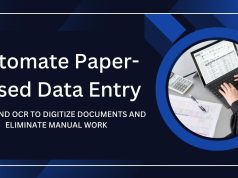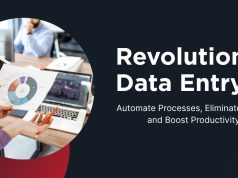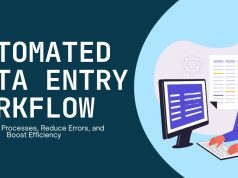Automated data entry for Xero boosts efficiency, reduces errors, and frees finance teams to focus on strategic tasks, supporting faster growth and better financial insights.
Manual data entry consumes countless hours that could be spent growing your business. For companies using Xero as their accounting software, automated data entry represents a game-changing opportunity to eliminate repetitive tasks, reduce human error, and free up valuable resources for strategic initiatives.
Automated data entry systems can process invoices, receipts, bank transactions, and other financial documents without human intervention. These systems use advanced technologies like optical character recognition (OCR), machine learning, and artificial intelligence to extract relevant information and input it directly into your Xero account.
The impact extends far beyond simple time savings. Businesses implementing automated data entry solutions report improved accuracy rates, faster month-end closures, and enhanced cash flow visibility. This transformation allows finance teams to shift from data processing to data analysis, providing better insights for business decisions.
What Is Automated Data Entry for Xero?

Automated data entry for Xero involves software solutions that capture, process, and input financial data directly into your Xero accounting system without manual intervention. These systems can handle various document types, including supplier invoices, customer receipts, bank statements, and expense reports.
The automation process begins when documents arrive through email, scanning, or digital upload. Advanced algorithms then extract key information such as vendor names, amounts, dates, and account codes. This data flows seamlessly into Xero, creating appropriate transactions, invoices, or journal entries based on predefined rules.
Modern automated data entry solutions integrate directly with Xero through secure APIs, ensuring real-time synchronization and maintaining data integrity. The system learns from your existing data patterns, improving accuracy over time and adapting to your specific business requirements.
Key Benefits of Automated Data Entry

Dramatic Time Savings
Manual data entry typically requires 5–10 minutes per document. Automated systems process the same documents in seconds. For businesses handling hundreds or thousands of transactions monthly, this translates to dozens of hours saved each week.
Learn how to create a fully automated data entry form in Excel for similar efficiency gains..
Enhanced Accuracy
Human error rates in manual data entry range from 1-5%, leading to costly mistakes and time-consuming corrections. Automated systems achieve accuracy rates above 95%, with many solutions reaching 98-99% accuracy for standard document formats.
Improved Cash Flow Management
Faster processing means better visibility into your financial position. Automated data entry enables real-time updates to your Xero dashboard, helping you make informed decisions about payments, collections, and investments. For insights on website integration and efficiency, check out website data entry automation: key to efficiency.
Scalability Without Additional Staff
As your business grows, automated systems handle increased transaction volumes without requiring additional personnel. This scalability proves particularly valuable during peak periods or rapid expansion phases.
Better Compliance and Audit Trails
Automated systems create detailed logs of all processed documents, including timestamps, processing rules applied, and any exceptions flagged. This comprehensive audit trail simplifies compliance requirements and supports financial audits. For broader AI automation applications, see AI data entry is revolutionizing CRM automation.
Popular Automated Data Entry Solutions for Xero

Receipt Bank (Now Dext)
Receipt Bank offers comprehensive document processing capabilities, handling invoices, receipts, and bank statements. The platform uses machine learning to improve accuracy over time and provides mobile apps for on-the-go document capture.
Hubdoc
Owned by Xero, Hubdoc specializes in fetching documents directly from supplier portals and processing them automatically. The solution excels at handling recurring suppliers and standardized document formats.
AutoEntry
AutoEntry focuses on high-volume transaction processing, making it ideal for businesses with extensive supplier networks. The platform offers advanced approval workflows and exception handling capabilities.
Lightyear
Lightyear provides end-to-end accounts payable automation, combining document processing with approval workflows and payment automation. The solution integrates seamlessly with Xero’s project tracking and inventory management features.
Implementation Considerations
Data Security and Privacy
When selecting an automated data entry solution, prioritize vendors with robust security measures. Look for SOC 2 compliance, encryption in transit and at rest, and secure data centers. Ensure the solution meets your industry’s specific regulatory requirements.
Integration Complexity
Evaluate integration with Xero and other systems like banking platforms and CRMs. For tips on applying data-driven solutions to business strategies, see a complete guide to data-driven digital marketing.
Training and Change Management
Successful implementation requires proper training for your finance team. Plan for transition periods where automated and manual processes run parallel, allowing staff to become comfortable with new workflows.
Cost-Benefit Analysis
Calculate the total cost of ownership, including subscription fees, implementation costs, and ongoing support. Compare this against current manual processing costs, including salary expenses and error correction time.
Best Practices for Success
Start with High-Volume, Standardized Documents
Begin automation with your most frequent, standardized document types. These typically yield the highest accuracy rates and provide quick wins that build confidence in the system.
Establish Clear Processing Rules
Define consistent rules for account coding, supplier matching, and exception handling. Well-defined rules improve accuracy and reduce manual interventions.
Monitor and Optimize Regularly
Review processing accuracy reports monthly and adjust settings as needed. Most solutions provide dashboards showing processing volumes, accuracy rates, and common exceptions.
Maintain Data Quality Standards
Clean, well-organized master data improves automation accuracy. Regularly update supplier information, chart of accounts, and processing rules to maintain optimal performance.
Measuring Success
Track key metrics to evaluate your automated data entry implementation’s success. Processing time reduction should show immediate improvement, with many businesses reporting 80-90% time savings within the first month.
Accuracy improvements become evident through reduced error correction time and fewer month-end adjustments. Monitor these metrics monthly to identify trends and opportunities for further optimization.
Employee satisfaction often increases as staff moves from repetitive data entry to more strategic activities. Survey your finance team regularly to understand how automation affects their job satisfaction and productivity.
Future of Automated Data Entry
Artificial intelligence continues advancing automated data entry capabilities. Machine learning algorithms now handle complex document layouts and non-standard formats with increasing accuracy. Natural language processing enables systems to interpret context and make intelligent coding decisions.
Integration capabilities are expanding beyond accounting software to encompass entire business ecosystems. Future solutions will seamlessly connect with procurement systems, project management tools, and business intelligence platforms.
Real-time processing is becoming standard, enabling immediate visibility into financial positions and supporting rapid decision-making. This evolution transforms accounting from a historical reporting function to a forward-looking strategic resource.
Common Challenges When Automating Data Entry in Xero
While automation delivers transformative benefits, many businesses encounter hurdles during adoption. One of the most common challenges is dealing with inconsistent document formats—especially when suppliers frequently change invoice layouts or send handwritten receipts. Although modern OCR and AI tools are advanced, inconsistency can still cause extraction errors or exceptions that require manual review.
Another challenge is resistance from internal teams. Employees used to manual processes may initially distrust automated outputs or fear that automation will replace their roles. This often results in underutilization of the system or continued reliance on manual workarounds. Clear communication and hands-on training are essential to overcoming this hesitation.
Data reconciliation issues also arise when businesses have outdated or incomplete supplier records. If vendor details don’t match, automated tools may fail to assign invoices correctly or duplicate entries. Cleaning up master data and maintaining consistent naming conventions can significantly reduce friction.
Finally, some businesses underestimate the ongoing monitoring required. Automation does not mean “set and forget”—regular optimization ensures the system continues to deliver high accuracy as document patterns evolve.
How Automated Data Entry Transforms the Role of the Finance Team
One of the most profound outcomes of adopting automated data entry in Xero is the shift in how finance professionals spend their time. Instead of repetitive, manual data entry tasks, they can transition into becoming strategic analysts who contribute directly to business growth.
With automation handling the bulk of transaction processing, finance teams gain the capacity to focus on forecasting, trend analysis, vendor performance evaluation, and cash flow optimization. This transition not only improves operational efficiency but also enhances the overall strategic decision-making process within the organization.
Employees also report higher job satisfaction when freed from monotonous tasks. Automation encourages professional development by enabling teams to take on more analytical, meaningful responsibilities. Over time, this shift elevates the finance department from a back-office cost center to a strategic business partner.
Industry Use Cases: How Different Sectors Benefit from Xero Automation
Automated data entry isn’t limited to one specific industry. Each sector gains unique advantages:
Retail & E-commerce
These businesses generate high volumes of invoices, receipts, and supplier transactions. Automation accelerates reconciliation, making it easier to manage stock flow, supplier payments, and daily sales summaries. With real-time updates in Xero, retailers can make faster purchasing decisions and maintain optimal inventory levels.
Professional Services
Consultants, agencies, and freelancers benefit from automated expense tracking and simplified billing. Receipts from travel, meetings, and project-related purchases can be processed instantly, ensuring accurate job costing and timely invoicing.
Construction & Trades
Construction companies often deal with large numbers of supplier invoices, subcontractor bills, and purchase orders. Automated systems help maintain accurate project budgets and support compliance with industry-specific financial requirements.
Hospitality
Restaurants and hotels handle significant daily expenses, including food suppliers, utilities, and payroll-related documents. Automation streamlines accounts payable, improves cash flow visibility, and reduces the time spent closing books each month.
Each industry experiences measurable improvements in speed, accuracy, and financial clarity when automating their Xero workflows.
How to Choose the Best Automated Data Entry Tool for Xero
Selecting the right automation tool requires careful consideration of your business’s size, document volume, and workflow complexity. Start by assessing the number of invoices, receipts, and statements your team processes monthly. High-volume businesses typically benefit from advanced AI tools like AutoEntry or Lightyear, while smaller organizations may prefer straightforward solutions like Hubdoc or Dext.
Next, evaluate whether you need extra features such as approval workflows, multi-currency support, line-item extraction, or supplier portal fetching. These advanced capabilities can significantly reduce manual intervention for more complex financial environments.
Support quality is another crucial factor. Having responsive customer service ensures that any issues—especially during onboarding—are resolved quickly. Finally, consider scalability. Choose a solution that can grow with your business, handle increased volume, and integrate seamlessly with your expanding tech stack.
Taking the Next Step
Automated data entry to Xero offers compelling benefits for businesses ready to modernize their financial processes. The technology has matured to provide reliable, accurate processing for most document types, while integration capabilities ensure seamless workflows.
Success requires careful planning, appropriate solution selection, and proper implementation. Start by evaluating your current manual processes, identifying high-impact automation opportunities, and researching solutions that align with your specific needs.
The investment in automated data entry typically pays for itself within months through time savings and improved accuracy. More importantly, it positions your business for scalable growth while freeing your team to focus on strategic activities that drive business success.
Frequently Asked Questions (FAQ)
Is automated data entry for Xero accurate enough to trust?
Yes. Modern automation tools achieve 95–99% accuracy, depending on document quality. Over time, machine learning improves accuracy even further as the system learns your patterns.
Do I still need to review transactions after automation?
While automation handles most tasks, periodic review is recommended to ensure everything is being coded correctly—especially during the initial onboarding stage.
Is it safe to connect third-party automation tools to Xero?
Reputable tools use secure APIs, data encryption, and industry-standard certifications like SOC 2. Always evaluate a provider’s security measures before integrating.
Can automated data entry handle multi-currency transactions?
Yes. Most advanced tools support multi-currency invoices, automatically extracting foreign amounts and syncing them into Xero with correct exchange rates.
What types of documents can be automated?
Invoices, receipts, bank statements, credit notes, purchase orders, expense reports, and sometimes contracts or PDFs with structured financial data.
Will automation replace my finance team?
No. Automation eliminates repetitive tasks, allowing your team to focus on analysis, strategy, and oversight rather than manual entry.
How long does it take to implement automated data entry for Xero?
Most businesses can be fully operational within days. More complex setups involving approval workflows or multi-entity structures may take a few weeks.
What is the cost of automated data entry tools?
Pricing varies depending on volume and features. Small businesses may pay $15–$50/month, while high-volume enterprises may invest $100–$400/month.
Can I automate all data entry tasks in Xero?
While most document types can be automated, irregular formats or handwritten documents may still require manual intervention.
What’s the biggest benefit of automating data entry in Xero?
The combination of time savings, accuracy, and real-time financial visibility, which collectively lead to better business decisions and scalable growth.










